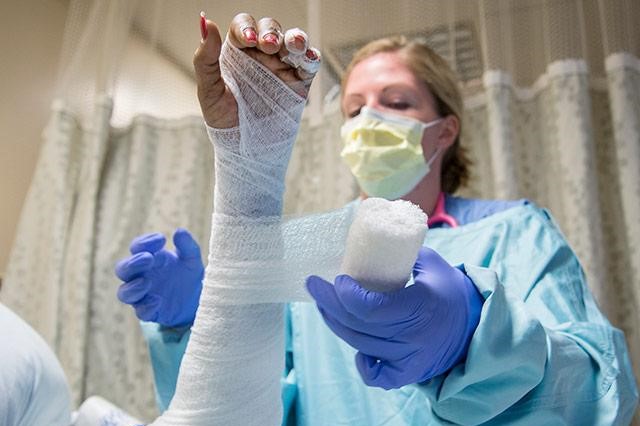
Burns, first aid: how to intervene, what to do
Burns are tissue damage from hot liquids, the sun, flames, chemicals, electricity, steam and other causes. Kitchen-related injuries from hot drinks, soups and microwaved foods are common among children
Major burns need emergency medical help.
THE RADIO OF THE WORLD’S RESCUERS? VISIT THE RADIO EMS BOOTH AT EMERGENCY EXPO
Minor burns can usually be treated with first aid
When to seek emergency care
Call Emergency Number or seek immediate care for major burns, which:
- Are deep, involving all layers of the skin
- Cause the skin to be dry and leathery
- May appear charred or have patches of white, brown or black
- Are larger than 3 inches (about 8 centimeters) in diameter
- Cover the hands, feet, face, groin, buttocks or a major joint, or encircles an arm or leg
- Are accompanied by smoke inhalation
- Begin swelling very quickly
Electrical burns, including those caused by lightning, and major chemical burns need emergency medical care.
A minor burn might need emergency care if it affects the eyes, mouth, hands or genital areas.
Babies and older adults might need emergency care for minor burns as well.
TRAINING IN FIRST AID? VISIT THE DMC DINAS MEDICAL CONSULTANTS BOOTH AT EMERGENCY EXPO
Treating major burns
Until emergency help arrives:
- Protect the burned person from further harm. If you can do so safely, make sure the person you’re helping is not in contact with the source of the burn. For electrical burns, make sure the power source is off before you approach the burned person. Don’t try to remove clothing stuck in the burn.
- Make certain that the person burned is breathing. If needed, begin rescue breathing if you know how.
- Remove jewelry, belts and other tight items, especially from the burned area and the neck. Burned areas swell quickly.
- Cover the burn. Loosely cover the area with gauze or a clean cloth.
- Raise the burned area. Lift the wound above heart level if possible.
- Watch for signs of shock. Signs and symptoms include cool, clammy skin, weak pulse and shallow breathing.
Treating minor burns
For minor burns:
- Cool the burn. Hold the area under cool (not cold) running water for about 10 minutes. If the burn is on the face, apply a cool, wet cloth until the pain eases. For a mouth burn from hot food or drink, put a piece of ice in the mouth for a few minutes.
- Remove rings or other tight items from the burned area. Try to do this quickly and gently, before the area swells.
- Don’t break blisters. Blisters help protect against infection. If a blister does break, gently clean the area with water and apply an antibiotic ointment.
- Apply lotion. After the burn is cooled, apply a lotion, such as one with aloe vera or cocoa butter. This helps prevent drying and provides relief.
- Bandage the burn. Cover the burn with a clean bandage. Wrap it loosely to avoid putting pressure on burned skin. Bandaging keeps air off the area, reduces pain and protects blistered skin.
- If needed, take a nonprescription pain reliever, such as ibuprofen (Advil, Motrin IB, others), naproxen sodium (Aleve) or acetaminophen (Tylenol, others).
Read Also:
Emergency Live Even More…Live: Download The New Free App Of Your Newspaper For IOS And Android
What Should Be In A Paediatric First Aid Kit
Ukraine Under Attack, Ministry Of Health Advises Citizens About First Aid For Thermal Burn
Electric Shock First Aid And Treatment
RICE Treatment For Soft Tissue Injuries
How To Carry Out Primary Survey Using The DRABC In First Aid
Heimlich Maneuver: Find Out What It Is And How To Do It
The Patient Complains Of Blurred Vision: What Pathologies Can Be Associated With It?
A Tourniquet Is One Of The Most Important Pieces Of Medical Equipment In Your First Aid Kit
12 Essential Items To Have In Your DIY First Aid Kit
First Aid For Burns: Classification And Treatment
Compensated, Decompensated And Irreversible Shock: What They Are And What They Determine


